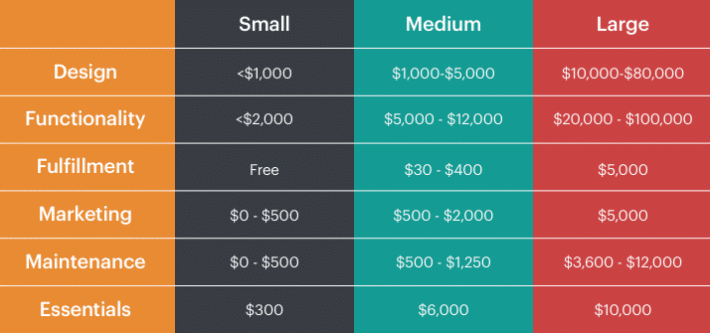Wondering how much an ecommerce website costs? Well, it really all depends on your needs, the product that you’re selling, and the volume of traffic to your website. While some of the larger ecommerce websites can rack up hefty bills, if you’re a small or mid-size company whose requirements aren’t too complex, an ecom website doesn’t have to cost too much. It’s a good idea to focus on optimizing your budget and making your website as cost-effective as possible.
What does an ecommerce website cost?
I’m sorry to say that there’s no one-size-fits-all or straightforward answer to what the cost of an ecommerce website is: the amount will vary from business to business. There are, however, some best practices you can follow to ensure your website is cost-effective. When doing this, being strategic in your approach will mean you can optimize your resources and get the most out of them.
For instance, if you’re still growing your online business, there’s no immediate rush to spend oodles on fancy web development: a sleek and simple online listing of your available items will be enough to get you going. All you need is a user-friendly interface that you can manage on your own. There are also plenty of free and easy-to-use plugins that make web development really accessible and affordable. For example, SEO is vital for a good ecommerce website, but instead of running pricey audits or hiring expensive professionals, you can start by using something like Yoast, an SEO plugin that has all the tools you need to get started and is also completely free!
Similarly, you can integrate basic ecommerce tools, like Shopify, with your website. Even if you don’t have advanced knowledge and skills in web development, tools like these make it really easy to build a modern and responsive ecommerce website without breaking your budget. You can also choose from a huge range of ecommerce site templates to make your online store look professional. Templates offer a range of customizable options for things like color motif, photos, and themes, allowing you to easily mould it to fit your style and image.
Building an ecommerce website can cost anywhere from a few hundred dollars to millions of dollars – but more expensive doesn’t necessarily mean better. You must carefully consider what you really need based on the budget that you can afford.
If you’re an SME or are looking to grow, you may want to invest more in your redesigning an existing or building a new ecommerce site, rather than paying for something more robust that you won’t be able to take full advantage of yet. The latter is something you can think about when your company begins selling a lot of products, or shipping overseas. Until then, focus your website budget in the areas that will pave the way for you to become that ecommerce giant!
Here is an infographic to visually showcase how our website pricing would fall:
Here are some of the major aspects to consider:
Domains and web hosting
A domain is a unique name that corresponds to your business or organization. More simply, it’s the URL by which your website can be found. When hosted, a domain corresponds to a unique IP address, which is a string of numbers and dots specifying servers. Technically, a website might be hosted on several servers because of the many resources it contains.
The price of web hosting can vary, and depends on the size of your site. In many cases, the hosting is included with the domain. In other cases, you need to buy them separately. Depending on how you do it, you’ll either pay a monthly or annual fee to a hosting provider, and it’s important to do your research so you know you’re getting something that’s fit for your purpose.
When you buy a domain name and subscribe to a web hosting service, you’re also given access to a CMS (Content Management System), like WordPress. From here, you’ll be able to use free web design templates or themes that come with the CMS, as well as make use of various tools from the plugin library. A lot of the design tools on CMSs like WordPress are free, so this can open up other areas of your budget without sacrificing on design.
If you decide that you’d prefer to buy a more professional template, prices can range between tens and hundreds of dollars. On the other hand, if you have a larger budget and you don’t want to use templates, you can hire a marketing agency or web designer to build your ecommerce site around your exact specifications. This will cost hundreds to thousands of dollars, depending on the complexity of the design and the experience of who you hire.
Order and payment processing
If you want a convenient order and checkout process for your customers, you’ll need to integrate a payment system. One simple way to do this is to add an order form and a PayPal merchant account button on your website. This could cost you as much as 2.9% plus $0.30 per transaction. Alternatively, you can also use the more advanced features offered by businesses like Authorize, where the monthly subscription fee usually sits at around $25.
Marketing and content
If you want your website to rank high in the SERPs (search engine results pages), you should have a bulletproof SEO strategy and ecommerce marketing plan – and a crucial part of both of these is content marketing. You should ensure that your website is regularly updated with new content – we believe this is key to business success.
While you can do this yourself, especially if you run a small business, you might want to consider hiring a marketing agency or team if you’re growing or your in-house team doesn’t have the capacity, expertise or time. The cost of doing this will depend on your goals and needs.
Does the ecommerce platform I choose impact cost?
There are several platforms that you will need in order to operate your website, from web hosting and payment processing platforms, to databases and email autoresponders. Different platforms have their own sets of advantages and disadvantages, as well as different prices depending on the features and functions they offer – and whether you want to customize them. The platforms you choose will definitely have an impact on the total cost of your ecommerce website.
How does web design impact the cost of an ecommerce website?
Design can either drive up the cost of your ecommerce website, or help to make it more manageable – it all depends on what you choose. If you decide to use a web designer to build your site from scratch, it might be more expensive, but you’ll get exactly what you want.
However, the cost of this will vary depending on who you hire and the complexity of the design. Alternatively, you can make use of free web design templates if you need to focus your budget in other areas – but you’re then constricted in how your site functions and what it looks like.
I want a customized ecommerce site. Will that cost more?
While there are free website templates you can customize, you’ll only be able to do this up to a certain point. If you want more advanced features or more control over your site, you’ll probably need to either purchase a premium template or hire a web developer or marketing agency.
When working with a web developer or an agency, you’ll be able to specify exactly what you want, and they’ll be able to implement it for you. They can also suggest useful features that you probably haven’t thought about.
What about web hosting?
You can buy a domain name and web hosting service from any domain name provider, including GoDaddy, HostGator and SquareSpace. With these providers, you choose your own domain, as long as it’s available, and enter into either a monthly or yearly subscription.
You can also pay extra for additional features, such as customized emails. The hosting cost for an ecommerce website can go as high as several hundreds of dollars because of the SaaS or software that’s included in the package.
How do I know I’m getting good value for my ecommerce website?
If your ecommerce website is attracting a high volume of visitors and has a high conversion rate because of the improvements that you’ve made, then you can rest assured you’re getting good value. However, if your expenses on website improvements are greater than the revenues generated, you may want to revisit your ecommerce conversion rates as you’re probably not getting good value.
You can use several metrics to objectively measure the effectiveness of your ecommerce website. These include things like bounce rate, cart abandonment rate, time spent on website, click-through rate, email response rate and, perhaps the most important one, conversion rate.
What About The Ongoing Costs Of Running An Ecom Site?
Depending on the scale of your operation and the size of your target market, the cost of operating an ecommerce website can range from hundreds to thousands to millions of dollars. The cost of an ecom site doesn’t only include the expenses of the online operation, like website development, but also on the salaries of office employees, payments for supplies, warehouse storage and delivery logistics, electric bills, and other overheads.



